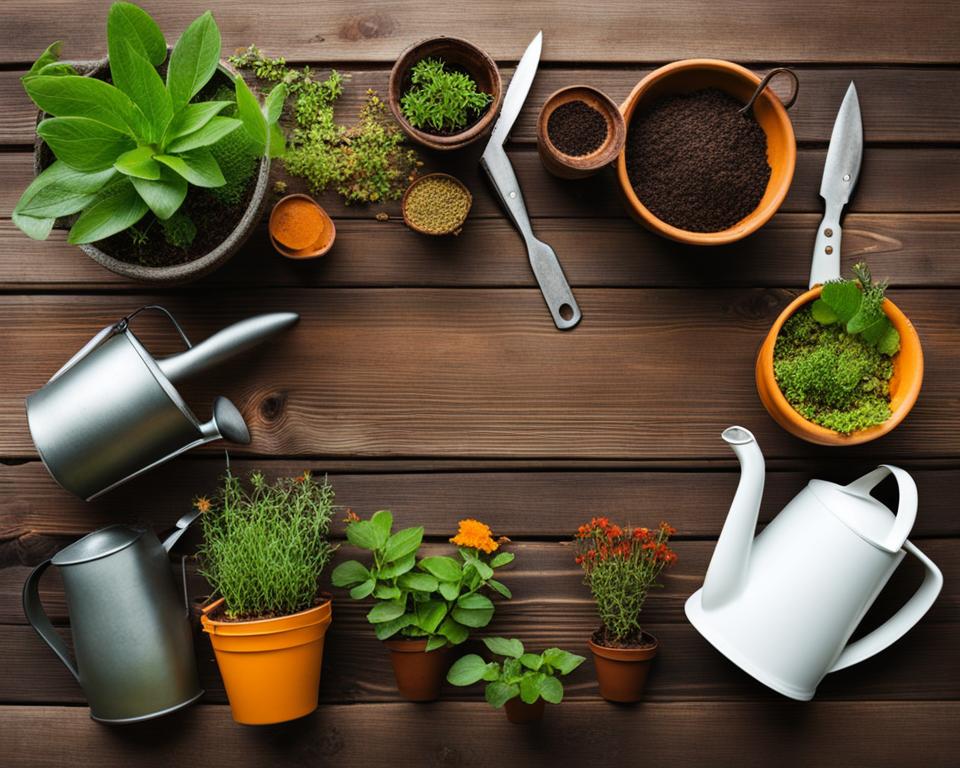Imagine transforming your urban space into a lush escape with the wonders of nature at your fingertips. That’s the magic of urban gardening—an enriching endeavor that merges the beauty of the great outdoors with the convenience of city living. For many city dwellers across the United States, the allure of a fresh harvest and the serenity of a personal green space have turned the dream of a vibrant garden into a reality. Whether you have sprawling rooftop access or a cozy balcony, this field guide to urban gardening is your companion on the journey to creating your very own botanical haven.
With our urban gardening tips, you’ll learn how to cultivate a thriving patch brimming with life, all while reaping the benefits of a practice known for enhancing well-being and mental clarity. In this urban gardening essentials guide, we hand-hold you through selecting the right plants, employing the best techniques, and making the most of your city space—no matter the size. So, roll up your sleeves; it’s time to delve into the world of greenery where every bit of effort blossoms into a rewarding experience.
Key Takeaways
- Discover the essentials of starting and nurturing an urban garden in any city environment.
- Embrace the health and wellness benefits that come with tending to your own green space.
- Access practical urban gardening tips tailored to your living situation, be it large or small.
- Learn to navigate the various considerations, from plant choices to seasonal planning, crucial to urban gardening success.
- Utilize this field guide as your go-to resource for turning any urban area into a flourishing, green oasis.
The Rise of Residential Urban Gardening
As we witness an ever-increasing interest in sustainable living, the concept of residential urban gardening has taken root across bustling metropolises. This transformative hobby is not only redefining urban landscapes but also providing city dwellers with countless benefits that extend well beyond fresh produce. Urban gardening offers a remedial touch to the fast-paced urban life, bringing about a sense of wellness and ecological responsibility.
Reaping the Benefits of Urban Gardening
Urban gardens are more than just clusters of plants; they represent a lifestyle that cultivates well-being and community. Urban gardening benefits are profound—ranging from the mental clarity gained through engaging with nature to the physical advantages of fresh, organic produce. It’s a holistic approach to living that encourages environmental stewardship and personal health.
Whether you have a sprawling rooftop or a modest window sill, the inclusion of greenery in your urban abode can dramatically enhance your living space. Moreover, urban gardening practices help reduce urban heat island effect, improve air quality, and support biodiversity in cities struggling with habitat loss.
Planning: The First Step to a Flourishing Garden
Embarking on your urban gardening journey begins with a solid plan. As you delve into this beginner’s guide to urban gardening, remember that success hinges on mindful preparation. Here, you take into account the intricacies of your environment and match them with your ambitions and abilities. With planning, you ensure that each plant serves a purpose, whether for aesthetics, sustenance, or simply enjoyment.
| Consideration | Details | Resources |
|---|---|---|
| Space | Assess the area available, sunlight exposure, and possible container sizes. | Local garden centers, urban gardening workshops |
| Season | Understand which plants thrive in which seasons in your particular climate zone. | USDA Plant Hardiness Zone Map |
| Soil | Select an appropriate mix for your containers or raised beds formulated for urban settings. | Soil-testing kits, organic soil blends |
| Tools | Identify necessary basic tools such as trowels, pruners, and watering cans. | Neighborhood hardware stores, online retailers |
As you gather your urban gardening resources, consider joining local gardening clubs or online forums for advice tailored to your microclimate. With careful planning and a little bit of patience, you’re well on your way to creating a bloom-filled sanctuary that flies in the face of concrete and steel—your very own urban garden.
Understanding Seasonal Planting in the City
Mastering urban gardening techniques starts with a fundamental grasp of gardening by season. You have the power to turn the concrete jungle into a lush paradise by planting in the ground at the right time. Every season is a unique chapter in your urban gardening story, and knowing the optimal planting schedules is like reading the rhythm of nature’s pulse in your backyard.
Spring brings about the thawing of the urban soil, signaling a time for new beginnings. Your patience is key, as the soil must warm adequately before you sow your first seeds. By tuning into the seasonal shifts, you’ll maximize germination rates and seedling success.
Then comes the summer, which cradles your plants with long days of sunlight and the kind of warmth that accelerates growth. It’s the season where your gardening efforts are in full swing, rewarding you with vibrant blossoms and bountiful harvests.
As autumn approaches, it’s the season for preparation. Shorter days and chillier nights mean you should start planning for winter-hardy varieties. Think of it as setting the stage for the next act, so your garden doesn’t bow out when the curtain of winter falls.
Here’s a little seasonal wisdom:
- Spring: Focus on leafy greens and root vegetables that can handle those last surprising frosts.
- Summer: It’s perfect for tomatoes, peppers, and other sun-loving residents of your garden patch.
- Fall: Switch to cool-season crops like kale and spinach, which thrive as the temperatures drop.
Remember, every urban gardener’s almanac is different, based on climate zones and microenvironments. But with a finger on the pulse of seasonal planting, you’ll be harvesting the fruits of your labor all year round.
Field Guide to Urban Gardening: Choosing Your Crops
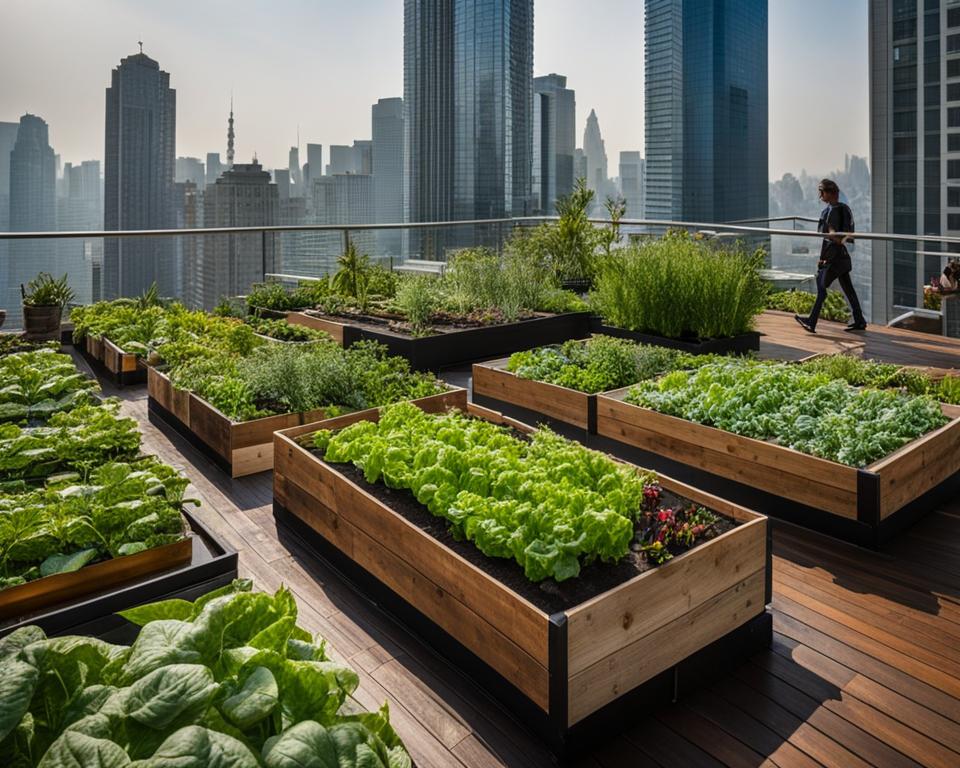
Delving into urban gardening ideas is an exciting pursuit that combines the pleasures of fresh air and fresh produce. Choosing which crops to grow is not just about what you’d like on your table, but also what will flourish in your unique urban environment. As you embark on this green adventure, let’s consider the key factors that will help you succeed.
Assessing Plant Seasonality and Preferences
Each season brings its own charm to urban gardening, and part of your role as a gardener is to understand the seasonality of plants. Spring might beckon for lettuce and kale, while summer calls for tomatoes and cucumbers. Start by marking your calendar with the local frost dates and use that as a guide for planting different seeds. Remember, plants have their own preferences; some crave the summer sun, others thrive in cooler temps. Your job? Listen to them and plan accordingly.
10 Easy-to-Grow Plants for Urban Beginners
Whether you’re looking to add a splash of color with flowers or aiming to grow fresh produce for your table, here’s a list of 10 easy-to-grow plants that are perfect for urban gardening novices:
- Cherry Tomatoes – Sun-loving and prolific, perfect for balconies.
- Radishes – Quick to harvest, ideal for gaining confidence.
- Basil – Aromatic and versatile for any urban herb garden.
- Cucumbers – Great for vertical planting, saving precious space.
- Spinach – Shade-tolerant and nutrient-rich for early spring planting.
- Peppers – Thrive in containers; pick a sunny spot for these colorful veggies.
- Zucchini – Bountiful producer even in small spaces.
- Mint – Easy to grow and maintain, but beware – it can spread quickly!
- Marigolds – Bright, cheerful, and can help deter pests.
- Strawberries – Sweet rewards, and they can be grown vertically, too.
Armed with these suggestions, dive into the delightful world of urban gardening. Tailor your plant choices to your environment and preferences, and before you know it, you’ll have nurtured a living, breathing splash of color and taste amidst the concrete and steel of the urban jungle.
Maximizing Limited Space with Creative Urban Garden Techniques
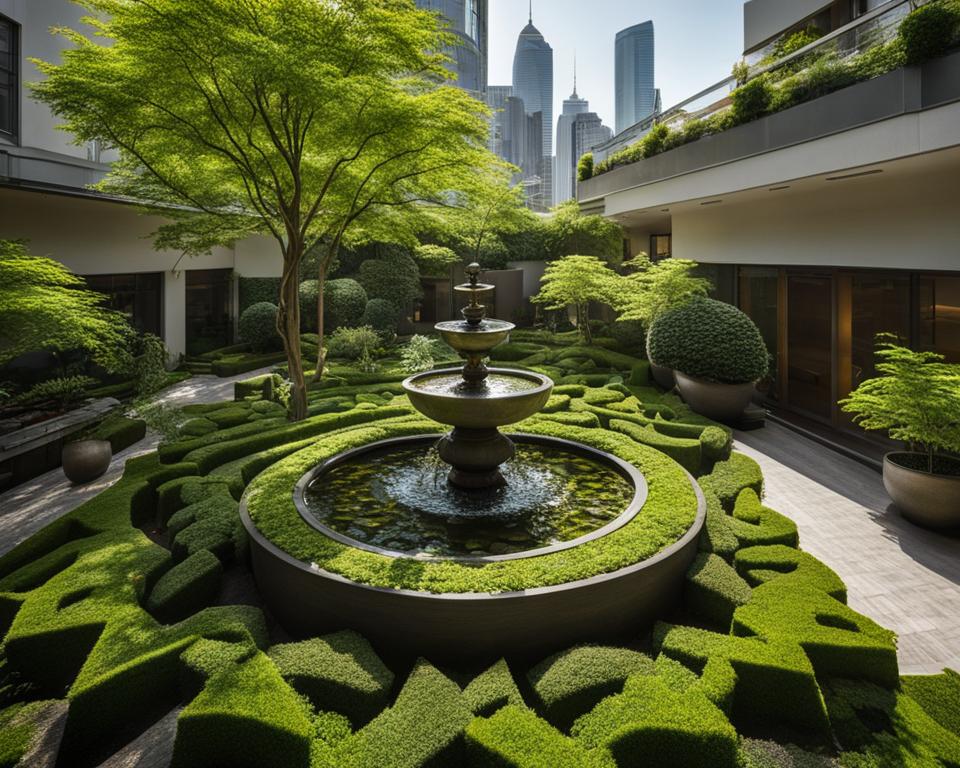
Delving into creative gardening can revolutionize the way you view your urban gardening space, turning seemingly minute areas into verdant sanctuaries. As an urban gardener, you can utilize a multitude of strategies to cultivate a lush array of small outdoor plants, crafting an oasis in even the most restricted of spaces.
Should you find your outdoor area constrained or your balcony too narrow for traditional garden beds, fear not. The art of urban gardening thrives on adaptation. Raised beds offer an elevated solution quite literally, leveraging vertical space. Alternatively, sleek containers ranging from rustic wooden crates to modern ceramic pots, enable indoor and outdoor plant cultivation that’s as stylish as it is green.
Container gardening is not only about flexibility but also about personalization. Here’s a glance at various container types to consider:
| Container Type | Material | Best For |
|---|---|---|
| Planter Pots | Ceramic, Plastic, Metal | Herbs, Succulents, Flowers |
| Hanging Baskets | Coir, Metal, Woven Fibers | Trailing Plants, Vines, Blooms |
| Window Boxes | Wood, Metal, Resin | Small Vegetables, Annuals, Perennials |
| Wall Planters | Recycled Materials, Metal | Ornamentals, Edible Greens |
Planting in containers also encourages you to explore creative gardening techniques like companion planting and theme gardens. Consider creating a “salad box” with different lettuce varieties or a “pollinator garden” filled with flowers that attract bees and butterflies. As you dive into these projects, you’ll find that limited space does not limit your capacity for a stunning and productive garden. So, embrace these small outdoor plants and creative gardening solutions to make the most of your urban gardening space.
Selecting the Right Location for Your Urban Garden
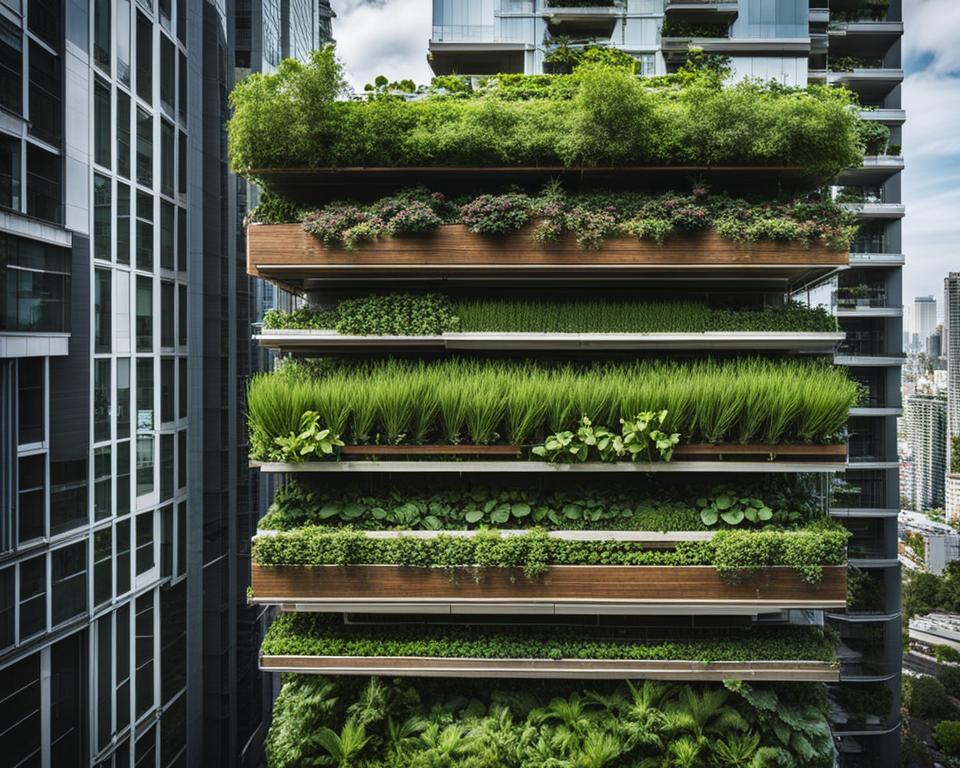
Transforming your urban dwellings into a green paradise begins with picking the perfect spot. It’s not just about finding a place to put your plants; it’s about exploring all possible urban gardening locations to maximize your space and yield. The beauty of urban gardening is the range of innovative options available, from quaint balconies to rooftop gardens that turn the city’s sky into a ceiling for your personal oasis.
From Balconies to Fire Escapes: Finding Your Garden Spot
Possessing a small balcony or access to a fire escape can be the starting point of your horticultural journey. These spaces might seem limited, but with a little bit of creativity, they can be turned into lush, productive, and gratifying garden spots. Even the smallest balcony can accommodate a collection of herb pots or a couple of tomato plants growing upwards towards the sun.
The Potential of Vertical Gardening and Living Walls
Vertical farms and living walls are not just agricultural innovations; they’re a revolution in urban gardening. These setups allow you to make the most of vertical spaces, growing an array of plants without needing a single patch of pure earth. A living wall can be a piece of art that breathes life into your home, creating a focal point that’s as functional as it is beautiful.
| Location Type | Advantages | Considerations |
|---|---|---|
| Balconies | Direct sunlight, private, can support containers and vertical planters | Weight restrictions, space limit, check for building regulations |
| Fire Escapes | Good airflow, possibility for hanging plants, easy to water | Must ensure access is unobstructed, limited space |
| Rooftop Gardens | Abundant sunlight, ample space, potential for larger setups | May need permission from building management, requires significant setup |
| Vertical Farms/Living Walls | Space-efficient, visually striking, can be indoor or outdoor | Requires a suitable wall and installation of supporting structures |
Whether you opt for a classic container garden on your balcony, a vibrant display on your rooftop, or an eco-chic vertical farm on your living room wall, each location comes with its own set of advantages and considerations. It’s about matching your gardening aspirations with the opportunities your urban environment offers. Embrace the spots you have, and watch as your greenery thrives against the concrete backdrop of the city!
Urban Gardening Ideas: Design and Aesthetics
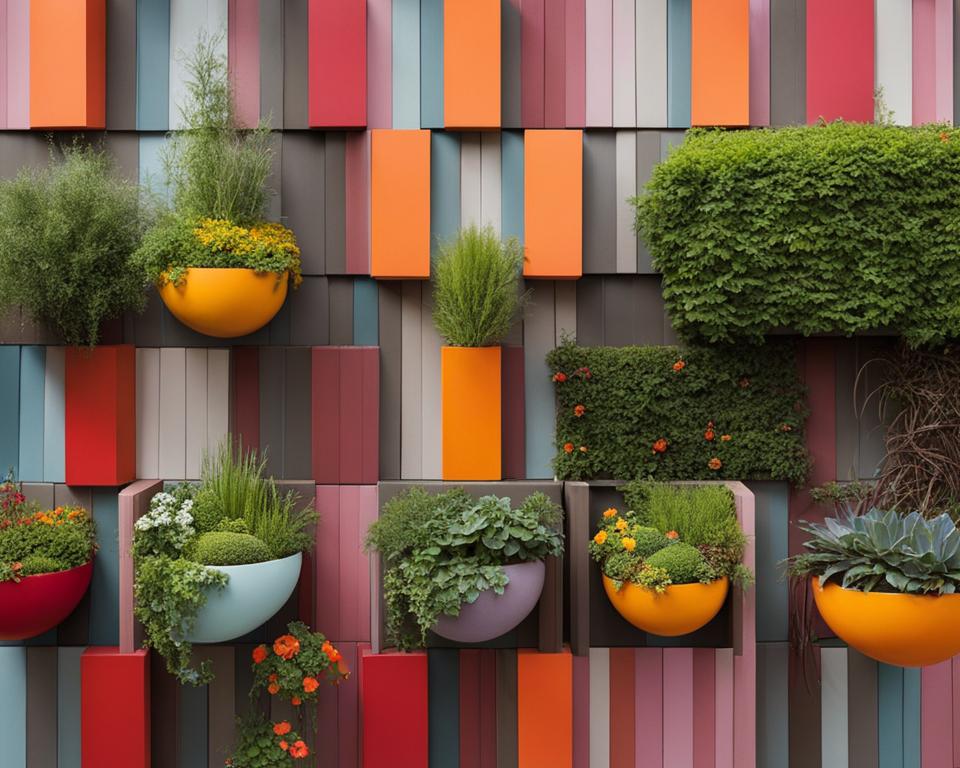
Transforming your outdoor space into an alluring sanctuary can be a fulfilling venture. Urban gardening design marries the practicalities of growing plants in a city environment with the creative expression of garden aesthetics. Your green space is not just a display of flora; it’s an opportunity to showcase your personal style and enhance the cityscape with verdant beauty.
Consider how the arrangement of plants, the choice of containers, and the interplay of textures can create a dynamic visual narrative in your urban setting. The thoughtful use of shapes and colors in your garden design can turn your balcony, terrace, or rooftop into an evocative piece of living art. To heighten the appeal, incorporate elements that reflect the architecture and spirit of your neighborhood, making your garden a natural extension of your urban habitat.
| Element | Design Idea | Aesthetic Impact |
|---|---|---|
| Plant Containers | Utilizing upcycled materials with vibrant colors | Adds a pop of visual interest and sustainable charm |
| Plant Arrangement | Grouping plants with varying heights and textures | Creates depth and a sense of abundance in small spaces |
| Lighting | String lights or solar-powered lamps | Enhances evening ambiance and highlights garden features |
A key aspect of urban gardening design is efficiency. In optimizing space, vertical gardens and hanging planters allow you to grow upwards, expanding your outdoor space without sacrificing form for function. This not only serves a practical purpose but also has the power to enchant and captivate, with living walls becoming the focal point of any urban oasis.
Remember, the ultimate goal of your urban garden should go beyond aesthetics; it’s about creating a personal space that rejuvenates your spirit and connects you to nature. Let your outdoor space be a testament to your creativity and a source of daily inspiration amidst the concrete landscape. Embrace the challenge of urban gardening design, and watch as your garden becomes a lush, serene retreat that you and your visitors can enjoy.
Nurturing Your Garden: Soil and Fertilizer Basics
As the bedrock of your urban garden, the success of your green space hinges on the quality of your garden soil mix and the application of fertilizer. A robust blend of soil teeming with organic matter and vital nutrients can dramatically enhance the growth and resilience of your plants.
Choosing the Right Soil Mix
Your garden’s yield, health, and beauty start with the soil. The best garden soil mix balances drainage with nutrient retention and is enriched with organic matter. This creates an environment where microorganisms thrive, supporting plant roots and facilitating growth. Look for soil mixes that cater to the specific needs of your urban gardening projects, or create your own blend tailored to your plants’ requirements.
The Do’s and Don’ts of Fertilizing
When it comes to fertilizing plants, there’s a thin line between just enough and too much. Proper fertilization encourages healthy growth, but overdoing it can lead to nutrient burn or environmental harm. It’s essential to understand the nutritional needs of your plants and to follow a balanced fertilizing regimen that replenishes the soil without leading to excess buildup of salts or minerals. Use slow-release or natural fertilizers to provide a steady supply of nutrients to your growing plants.
Choosing Urban Gardening Tools and Resources
As a gardening beginner, it’s essential to curate a set of garden tools that align with the unique demands of urban garden maintenance. The right equipment can dramatically simplify your gardening tasks, ensuring you spend less time struggling with inadequate tools and more time enjoying the fruits—and vegetables—of your labor. Let’s dig in to find out which tools will best support your urban oasis.
Starting a garden in tight spaces requires creativity and the correct tools. A versatile hand trowel, for example, is indispensable for transplanting bedding plants and herbs. Similarly, a sturdy pair of pruning shears is a must-have for shaping, keeping your plants tidy, and encouraging growth. Here’s a quick guide to equip you with critical insights into choosing tools that will make urban garden maintenance a breeze.
| Tool | Use | Benefit |
|---|---|---|
| Hand Trowel | Planting, transplanting, weeding | Precision in tight spaces |
| Pruning Shears | Trimming and shaping | Clean cuts for plant health |
| Watering Can | Watering plants | Controlled water distribution |
| Garden Hose with Adjustable Nozzle | Efficiently watering large areas | Customizable water flow, ease of use |
| Garden Fork | Aerating soil, breaking up clumps | Improved soil structure |
| Spade | Digging, edging, lifting sod | Multi-purpose digging tool |
Beyond tangible tools, resources such as local nurseries provide invaluable help, from plant recommendations to pest control advice. Engaging with gardening communities both online and in your neighborhood can also offer support and inspire exciting new ideas for your urban garden. Remember, the best tool you have is your enthusiasm to grow and learn. May your urban garden flourish!
Maintaining Your Urban Oasis: Watering and Care
As an urban gardener, you are the keeper of a precious green space in a concrete jungle. Tending to your garden requires consistent care and the use of mindful garden watering practices. Despite the bustling urban environment, your garden not only survives but thrives, becoming a personal sanctuary of tranquility. Becoming savvy with eco-friendly gardening techniques will not only nourish your plants but also contribute to a more sustainable planet.
Eco-Friendly Watering Practices
One of the cornerstones of eco-friendly gardening is the smart use of water. Employing methods such as drip irrigation can drastically reduce water waste and ensure that each drop is used effectively. Drip systems deliver water directly to the roots of your plants, minimizing evaporation and runoff. Collecting rainwater is another sustainable choice, allowing you to repurpose natural resources and shield your plants from chemical-laden tap water. Together, these strategies support a garden ecosystem that is resource-conscious and eco-sensitive.
Heat and Wind: Urban Challengers
Battling the urban gardening challenges of heat and wind requires innovation and resilience. High temperatures can quickly dehydrate your plants if you’re not vigilant, and gusty winds might disrupt tender shoots and dry out the soil. To protect your green oasis, consider creating windbreaks with sturdier plants or installing shading to blunt the heat during the sun’s peak hours. Regular monitoring and adjusting your care routine to respond to these challenges will keep your urban garden flourishing in the face of adversity. Remember, your persistence not only enhances your immediate environment but also contributes to the larger canvas of urban biodiversity.
FAQ
What are the benefits of urban gardening?
Urban gardening provides numerous benefits including improved mental health, emotional well-being, and physical activity. It can enhance your living space, offer fresh produce, and instill a sense of self-sufficiency and connection to nature.
What are the first steps to take when starting an urban garden?
Initially, plan your garden by considering the available space, sunlight, and what you’d like to grow. Research plant selection for the upcoming season, prepare your soil, and gather the essential tools needed for planting.
How does seasonality affect urban gardening?
Seasonality is pivotal in urban gardening as it dictates which plants will thrive at different times of the year. Understanding your local climate and selecting crops accordingly ensures a vibrant garden throughout the seasons.
What are some easy-to-grow plants for urban gardening beginners?
Beginners should consider starting with plants that are hardy and require minimal care, such as herbs like basil and mint, leafy greens like spinach and lettuce, and vegetables like tomatoes and bell peppers.
How can I garden in a small urban space?
Maximizing small spaces involves getting creative with containers, vertical gardens, and wall planters. Use balconies, windowsills, and any little nook that can accommodate pots or planters to create your urban oasis.
How do I find the right location for my urban garden?
Look for spots that receive sufficient sunlight, are protected from strong winds, and have easy access to water. Balconies, rooftops, and even fire escapes can serve as potential gardening locations.
What should I consider when designing my urban garden for aesthetic appeal?
Consider the visual aspects of your garden, like plant heights, colors, and textures. Aim to create an inviting and harmonious space that reflects your personal style and complements the urban environment.
How do I choose the right soil and fertilizer for my urban garden?
Opt for a soil mix that is rich in organic matter and well-draining. When fertilizing, use the correct ratios and apply during the growing season to provide adequate nutrients without overfeeding your plants.
What tools and resources should I have for urban gardening?
Your toolkit should include a trowel, pruners, watering can or hose, gloves, and potting soil. Utilize local nurseries, online forums, and community gardens for additional resources and support.
What are some eco-friendly watering practices for urban gardens?
Collecting rainwater, using drip irrigation, and watering during cooler parts of the day are all eco-friendly approaches. These practices conserve water and ensure deep watering that promotes healthy plant roots.
How can I protect my urban garden from heat and wind?
Install shade cloths or position taller plants to shield more delicate ones from the sun. Use wind barriers or select wind-tolerant plants to prevent damage from strong gusts.

